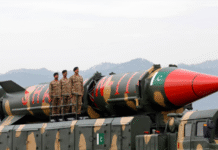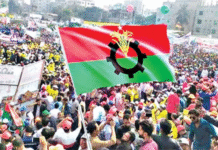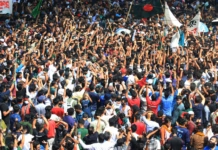Bengali Language Movement

On 21 March 1948, Mohammed Ali Jinnah, the Governor general of Pakistan, declared that Urdu would be the only official language for both West and East Pakistan. The people of East Pakistan (now Bangladesh), having mother language Bangla, started to protest against this. On 21 February 1952, (8th Falgun 1358 in the Bangla calendar), students in the present day capital city of Dhaka called for a provincial strike. The government invoked a limited curfew to prevent this and the protests were tamed down so as to not break the curfew. The Pakistani police fired on the students despite these peaceful protests and a number of students were killed. Four of them were Abdus Salam, Rafiq Uddin Ahmed, Abul Barkat and Abdul Jabbar.
On this day in 1952, after the “Principles Committee of the Constituent Assembly of Pakistan” announced that Urdu would be the only state language of East (now Bangladesh) and West Pakistan, a huge wave of protests erupted in Bangladesh where the majority spoke Bangla.
Politicians joined students in their demonstrations and the Pakistani Government responded by violently cracking down on the protesters. Over the course of one week (February 21-27, 1952), they killed student demonstrators, some directly in front of Dhaka Medical College.
On February 29th, 1956,Pakistan added Bengali as the second official state language after Urdu. Bangladesh won its independence from Pakistan in 1971.
International Mother Language Day is an observance held annually on 21 February worldwide to promote awareness of linguistic and cultural diversity and multilingualism. It was first announced by UNESCO in the Paris session on 17 November 1999. Its observance was also formally recognized by the United Nations General Assembly in its resolution establishing 2008 as the International Year of Languages.
International Mother Language Day originated as the international recognition of Language Movement Day, which has been commemorated in Bangladesh (formerly East Pakistan) since 1952, when a number of students including the students of the University of Dhaka were killed by the Pakistani police in Dhaka during Bengali Language Movement protests.
Bangla is the official language of Bangladesh. It is also spoken in West Bengal. Bangalees protected Bangla from the clutches of Pakistani oppressors in 1952 by preventing Urdu from being the state language of East Pakistanwhere a vast majority of people spoke in Bangla. Bangalees had to sacrifice lives for their mother tongue on 21st February, 1952. 21st February being declared International Mother Language Day by UNESCO, Bangla reached the peak of maturity.
Evolution
Bangla’s direct ancestor is a form of Magadhi Prakrit or Middle Indo-Aryan which descended from Sanskrit or Old Indo-Aryan. Bangla evolved mainly from Sanskrit. Also Hindi, Urdu, Farsi, English–all contributed lots of words and terms to form this language.
The Origin of Bangla Alphabet
Bangla alphabet originated from Brahmi alphabet of the Asokan inscriptions. The Bangla script in its present printed form took shape in 1778 when printing types were first cast by Charles Wilkins. There still remained a few archaic forms and these were finally replaced in the middle of the nineteenth century.
The Oldest Records
For old Bangla the only record is Charjapad discovered from a palace in Nepal by Haraprasad Shastri. It is a collection of the oldest verses thought to be the oldest records of Bangla literature. The language of Charjapad is basically vernacular, but at the same time it is also something of a literary language.
Two Styles
Bangla at the present day has two literary styles. One is called “Sadhu Bhasha” and the other “Chalit Bhasa“. The former is the traditional literary style based on Middle Bangla of the sixteenth century. The later is practically a creation of the present century, and is based on the cultivated form of the dialect and day-to-day talks. The difference between the two literary styles is not very sharp. The vocabulary is practically the same. The difference lies mainly in the forms of the pronoun and the verb. The Sadhu Bhasa has the old and heavier forms while the Chalit Bhasa uses the modern and lighter forms. The former shows a partiality for lexical words and for compound words of the Sanskrit type, and the latter prefers colloquial words, phrases and idioms. The Chalit Bhasa was first seriously taken up by Pramatha Chawdhury at the instance of Rabindranath Tagore during the early years of the first World War. Soon after Tagore practically discarded Sadhu Bhasa, and Chalit Bhasa is now generally favored by writers who have no particular fascination for the traditional literary style.
http://sildenafilnorxbest.com/ – best online canadian pharmacy – canada drug pharmacy – cialis coupon – otc sildenafil
online pharmacy canada – cialis free coupon – otc sildenafil – sildenafil citrate 20 mg – sildenafil generic
canadian drugs cialis | generic viagra online | pharmacy in canada | cialis free coupon | sildenafil 20 mg tablet









